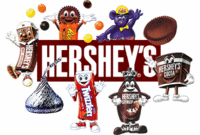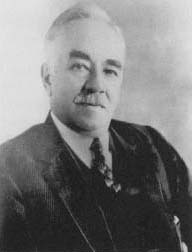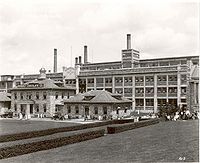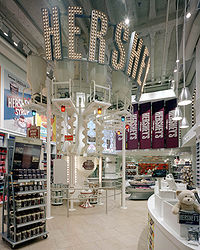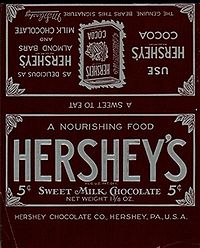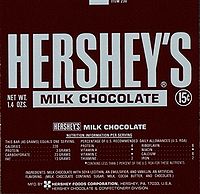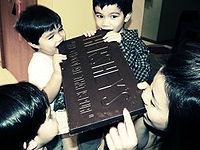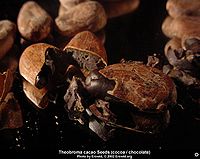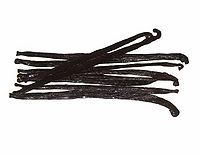The History of the Hershey's Chocolate Bar
The Hershey’s Company has been for the past century, the biggest North American manufacturer of chocolate goods. With a net revenue of almost 6 billion dollars in 2009, the Hershey’s bar remains an iconic image of the success of a global giant.
It is no surprise that today the Hershey's bar represents a legacy of one man's dream to bring milk chocolate to world in all shapes and sizes, a delicacy that up until the 1900's, had been a secret recipe controlled by swiss chocolatiers.
History
The story of the Hershey’s chocolate bar begins with Milton S. Hershey, who was raised in rural Pennsylvania. He apprenticed to a candy maker for four years, then proceeded to open his first candy business in Philadelphia in 1876. He worked hard for six years only to have this business fail. He then moved to Denver where he took up a job with a confectioner and learned the art of making caramels using fresh milk. He proceeded to try to open another candy business in New York. This business eventually failed followed by Hershey moving back to Lancaster and following up on the making of caramel. This time the company was successful and he founded the Lancaster Caramel Company, which shipped to all of the US and Europe.
Chocolate production didn’t come into the picture until the 1983 World Columbian Exposition in Chicago. It was there that Milton Hershey became fascinated with chocolate making, and moved to purchase some German machinery. Hershey followed this move by creating the Hershey’s Chocolate Company. Hershey toiled for years to perfect his recipe for milk chocolate, which at the time was still a novelty for the rich, and eventually developed the right combination of milk, sugar, and cocoa. This then lead to mass chocolate production, and was the leading means of creating affordable chocolates for all social classes. This lead to the creation of one of history’s most famous candies: The Hershey’s Bar.
With the success of the Hershey’s Chocolate Company, Hershey went on to sell the Lancaster Caramel Company in 1900 in order to focus on the manufacturing of chocolate goods. The Hershey Chocolate Company continued to grow in leaps and bounds up till the death of Milton Hershey in 1945. With demand ever increasing for chocolates, he opened a new factory in the town of Derry and broke ground in 1903.
With the death of Milton Hershey in 1945, the Hershey Chocolate Company evolved into the modern Hershey Company. During the years, the company has expanded and acquired many additional businesses such as San Giorgio Macaroni, Delmonico Foods, manufacturing and marketing rights to Rowntree Macintosh’s products, Y&S Candies (the makers of twizzlers), Dietrich Corp’s confectionary operations, Peter Paul/Cadbury U.S. Confectionary operations, and Ronzoni foods.
Hershey’s Company is now the leading manufacturer of all chocolate and non-chocolate confectionary food items. The company services over 90 countries worldwide, and provides jobs to over 13000 employees.
Brand Image
In the world of confection, the most all-American, people inspiring, and community oriented company has to be The Hershey Company. Although the name has been slightly changed over the years, the moral core of the brand has not.
Milton Hershey, who was a real man, achieved the American dream. The history of the company is proudly, and readily, available on the many websites they have created for the literal chocolate town of Hershey, PA. He wanted to create a company that depended on the American people for it’s success and achieved that. Hershey attached himself to the traditional underdog story that is so poplar in North America; he was a poor young man that, after some major set backs, but an abundance of hard work and honest confidence, became a full success in his chosen field. He stuck very true to his American roots, waiting for the day the Hershey’s Bar would be as identifiably American as the apple pie. His use of positive, easily identifiable propaganda tried to create connections of loyalty and patriotism to his company. Most of the ads that have survived show primarily white, adorable children having a fun time eating a safe, tasty treat. Also, in the time when this company was just coming to fruition, chocolate was a delicacy not offered to the common family. With the help of Hershey, high quality chocolate could now be enjoyed by anyone, adding more to their over all brand identity and mission to bring the best to everyone, no matter what their class.
Hershey Company wants you to look to the future and follow the long track of community efforts that have been taken by the company leaders through its long history. In the town of Hershey, a town Milton Hershey created to support the workers of his factory, were not just normal necessities such as banks, grocery stores, blacksmiths, and schools, but also a theme park, museums, swimming pools, a trolley system, and a live zoo, closed down during WWII, to give his citizens and tourists a reminder of his generous nature and educational outreach. The paper, run by the town, urged people to buy land to build on, but didn’t force them; their logic would only allow the opportunity if it wanted to be taken, rather than forcing its people to do anything. Hershey was all about giving opportunities for the people of America, including a union created in 1940, to set down roots in a town that they planned to live forever.
During WWII, Hershey made vast changes to their company to support the troops, in fact Hershey’s products were included as part of a soldier’s rations throughout their active service, and even their packaging was changed from tin foil to plastic glassine for the war efforts. The creation of the “Field Ration D” bar, an energy boosting troop bar, gave even more credence to their patriotic image.
The clear use of the founder’s hometown, due to it’s easily accessible ports and farm space, provided not only the exotic foreign ingredients such as cocoa beans and sugar, but a natural space for American cows to give their the fresh milk that made Hershey’s Chocolate so special. The use of people’s loyalty and patriotism was incredibly intelligent and, although they did not choose to focus on many international locations to sell their products, the loses they possibly had their have been left in the dust of their continued, ever vigilant success on the home front.
Packaging
The Hershey’s packaging had remained remarkably the same, up until a few years ago, mostly due to their corporate image and the necessity of keeping a reminder of their all-American roots, and the company’s age constant. In 1903, adding a little more to a very simple rich brown paper packaging, in gold coloring, changed to silver in 1912 along with the traditional block lettering, it read, along with the usual packaging, “The Genuine Bears This Signature”, including Milton Hershey’s signature on a golden line. A tin foil inner wrapper was devised to hold the chocolate itself. At this time the bars also included healthy marketing such as “More Sustaining Than Meat” trying to incorporate a care for the health of the average American, tying into their “honest ideals”.
During the 1950s, cocoa bean prices dramatically fluctuated, but Hershey wanted to keep their five cent bars the same price so, depending on the price of the beans at that time, the bar would change it’s size accordingly. As cost saving measures, right after WWII began, white glassine was introduced as an alternative to the tin foil they had previously used but was now needed for war efforts. Also, the embossing of the Hershey’s text was discarded in 1950. On November 24th 1969 they finally did change to a ten-cent bar, with more than double the weight of the five-cent bar. In 1973, they included nutritional information, one of the first in their field to do so on each package, and in 1975 included a UPC code on all packaging. In 1984 they changed the white glassine inner wrapper to tin foil again, the first time since 1942. To create a fresher product, 2003 marked the year the famous Hershey’s foil wrap and paper wrapper were traded in for a fin-seal film wrapper. Although some critics say they prefer the old fashioned packaging, the safety of the new wrapping is far more tamper proof. So much so that the change seems to be, unfortunately, necessary. The ideas of safety, simplicity, richness, and forward thinking American ties were all key aspects of the Hershey Chocolate Bar and it was, and will most probably always be, obvious in their packaging.
Ingredients And Their Origins
In 1900 Milton S. Hershey was driven into the chocolate manufacturing operation by the belief that everyone should be able to enjoy the great taste of milk chocolate, not just the wealthy. Hershey’s classic Milk Chocolate candy bar was first brought into the American market in 1910, and from this time onward it became the chocolate bar that would create what we know of today as the world wide Hershey’s Corporation. This milk chocolate candy bar has a combination of chocolate liquor, cocoa butter, sugar and milk and/or cream. Milk chocolate must contain at least 10% chocolate liquor and at least 12% total milk ingredients to produce what we know as the classic Hershey’s candy bar. Milton Hershey – in an effort to start producing this candy bar – returned to his birthplace of Derry Church, Pennsylvania, (now know as Hershey, PA) where the heart of the states dairy farms is located. Here, he was able to obtain the large supply of milk necessary (at least 12% per bar) to make his pure milk chocolate.
The timeless classic Hershey’s milk chocolate bar is made purely with milk chocolate, which itself is made from sugar, milk, cocoa butter, chocolate, soy lecithin, vanilla and artificial flavours. As we already know, Hershey set up his chocolate production in relation to the large supply of milk needed (Inc., 2009). However, all of the other ingredients are foreign to American soil and thus he had to import them to make what we know of today as the classic milk chocolate candy bar. Chocolate itself is produced from the seed of the tropical Theobroma cacao tree, and these seeds have an intense bitter taste and thus must be fermented to develop the flavour. After fermentation these beans (seeds) are dried, cleaned and roasted. Here, the shell is removed to produce ‘cacao nibs’, and once these nibs are ground into a ‘cocoa mass’ is the pure rough form of chocolate reached (Shopping.com, 2010). This cocoa mass is usually liquefied, and this is what we know as chocolate liquor, a main ingredient in his timeless recipe. Because this liquor comes from the seeds of a tropical plant, there is little doubt that this Latin American tree – one that once grew wild – was once used by peoples of the region long before Hershey was able to get a supply. There is clear evidence that the Mayan society used chocolate not only for subsistence purposes but for ritual reasons as well (LaShelle, 2010).
Sugar is one of the other main ingredients of the Hershey’s Milk Chocolate Bar. Sugar, just like chocolate, has a long history. Based on archeological evidence, sugar was introduced somewhere in the Polynesian islands, and travelled to India, where its popularity grew instantly (Barta, 2010). Just like chocolate, sugar was first utilized by the locals in its pure form, sugar cane. However, as soon as there was European contact, sugar cane became a cultivated plant on a much larger scale, producing sugar, which instantly became a hot commodity for only the wealthy in Europe. Sugar cane was eventually transported to other tropical regions, such as South America. As its production and thus supply grew, its value began to decrease and soon everyone (rich and poor) could acquire sugar. Today, sugar is inexpensive and bountiful (roughly 120 million tons consumed annually) and sugar cane plantations are dominated by Brazil, India, and the European Union (Barta, 2010). Soy lecithin is another major ingredient used to produce Hershey’s Milk Chocolate candy bar. Soy lecithin is one of the most complex and versatile substances derived from the soybean (Shurtleff & Aoyagi, 2007). The worlds earliest production of soy lecithin began in Europe, with first France then Germany leading the way. Today, the main countries that are refining soy oil – USA, Western Europe and Japan – are also the largest producers of soy lecithin.
The last ingredient used by Hershey’s to produce its classic candy bar is vanilla. Vanilla originated in Mexico, and the first keepers of it were the ancient Totonaco Indians. They were defeated by the Aztecs, and so were demanded to relinquish this secret, the fruit of the Tlilxochitl vine, vanilla pods. However, in turn the Aztec were conquered by the Spaniards, and their precious vanilla beans were returned to Spain and used with cocoa to produce a ‘pleasing drink’. Less then a century later vanilla was suggested to be used as a flavouring all by itself, and thus the versatility of the bean was finally uncovered. Today, there are four main areas that grow vanilla beans. Madagascar is the largest producer of vanilla beans in the world, followed by Indonesia. Together, Madagascar and Indonesia produce 90 percent of the world’s vanilla. Mexico, where vanilla originated, produces a small percent. And lastly, Tahiti is the fourth area that harvests vanilla. (Nielsen & Massey, 2007).
Works Cited
Barta, J. (2010, March 4). How Sugar is Made: The History. Retrieved April 3, 2010, from Welcome to the World of Sugar Technology: http://www.sucrose.com/lhist.html
Inc., H. (2009). Products. (M. Hershey, Producer) Retrieved April 3, 2010, from Hershey's: http://www.hersheycanada.com/en/products/details/hersheys/index.asp
LaShelle. (2010). Chocolate History: Who Invented Chocolate? Retrieved April 3, 2010, from Facts-About-Chocolate: http://www.facts-about-chocolate.com/chocolate-history.html
Nielsen, & Massey. (2007). The History of Vanilla. Retrieved April 3, 2010, from Nielsen - Massey Vanillas: Vanilla Specialists: http://www.nielsenmassey.com/historyofvanilla.htm
Shopping.com, I. (2010). Hershy's Milk Chocolate Bar. Retrieved April 3, 2010, from Epinions: http://www.epinions.com/review/Hershy_s_Milk_Chocolate_Bar/content_419469561476
Shurtleff, W., & Aoyagi, A. (2007). History of Soy Lecithin. Retrieved April 3, 2010, from Soy Info Center: http://www.soyinfocenter.com/HSS/lecithin1.php
Margolin, S. (2001, December 17). The Chocolate Market Unwrapped. Retrieved April 1, 2010, from Brand Channel: http://www.brandchannel.com/features_effect.asp?pf_id=71
Ellis, M., McCants, M., Frye, N., Miller, J., Polk, M., Rogers, G.. (2008, May 22). The Hershey Company-Introducing the World of Chocolate (2007). Retrieved April 1, 2010, from Washington IV: http://www.washingtoniv.com/?p=65
Inc., H. (2010, February). History: The Hershey Transit Company. Retrieved April 1, 2010, from Hershey Trolley Works: http://www.hersheytrolleyworks.com/content/history.html
Inc, H., (2010). Company History. Retrieved April 1, 2010, from Discover Hershey: http://www.hersheys.com/discover/history/company.asp
